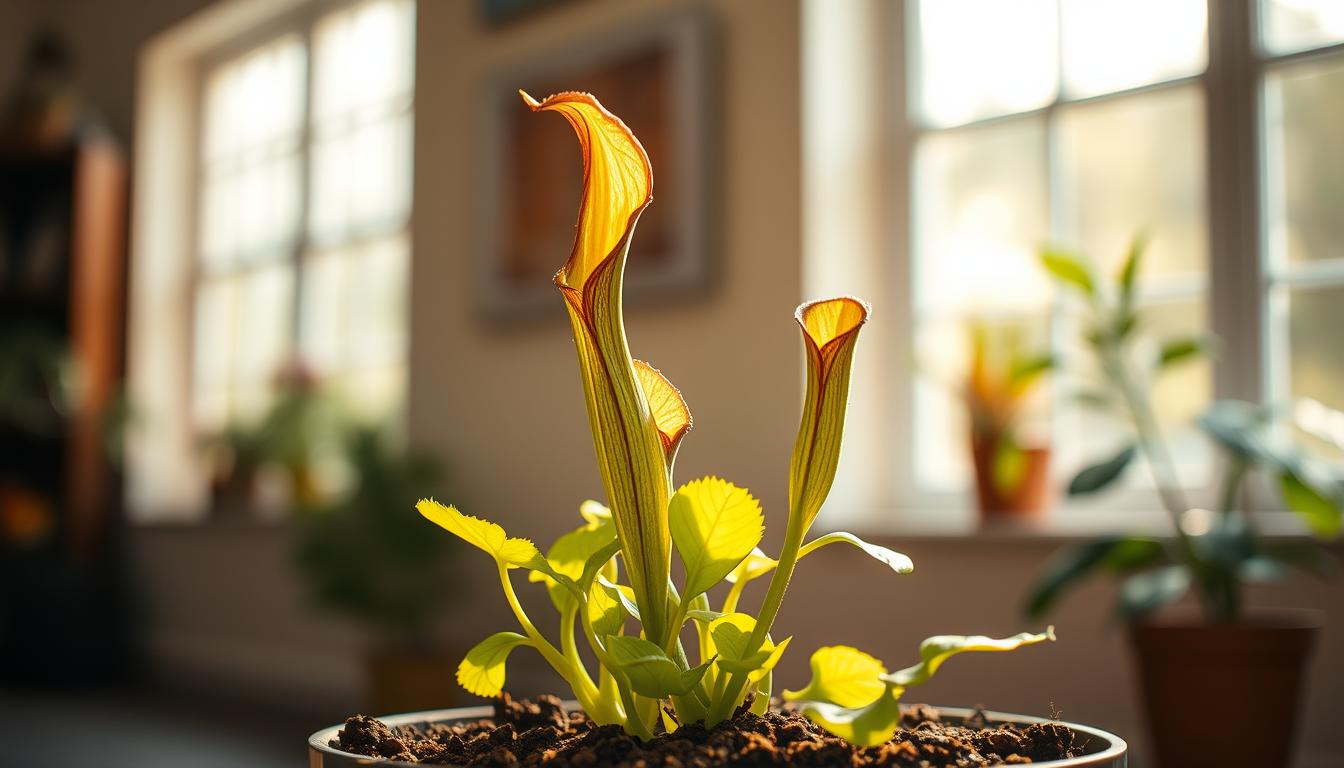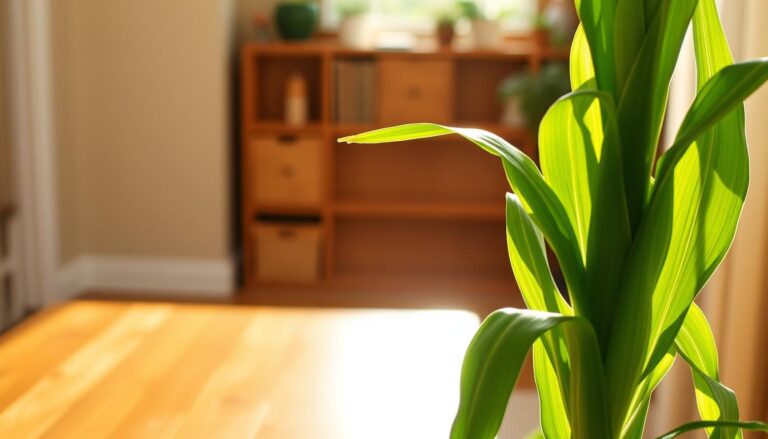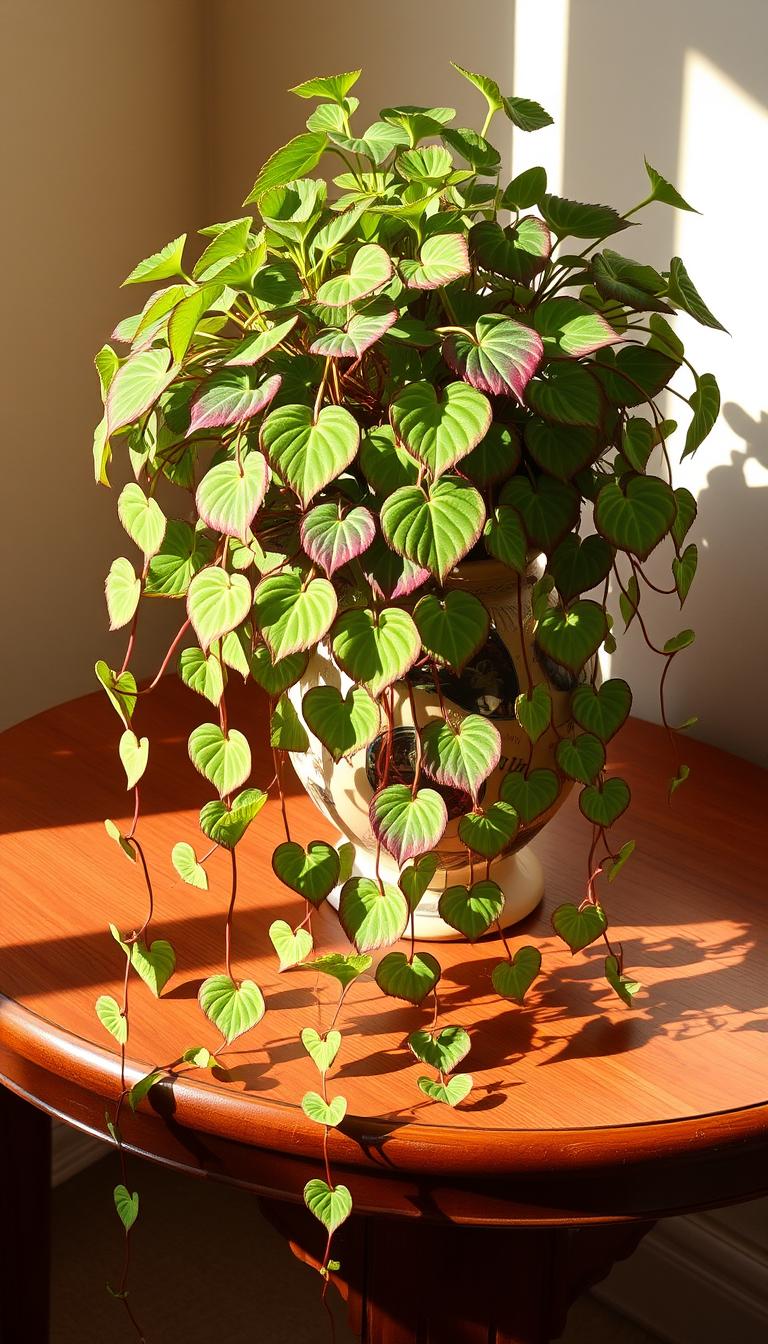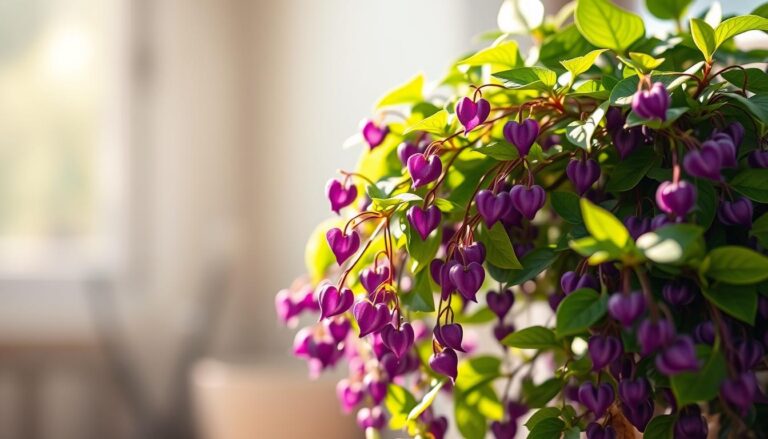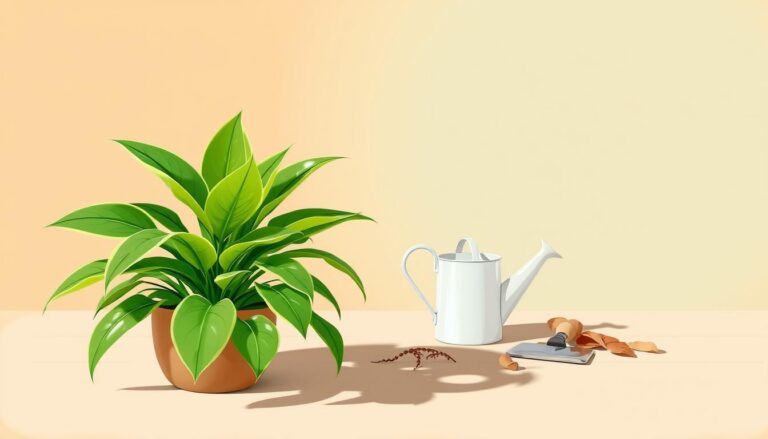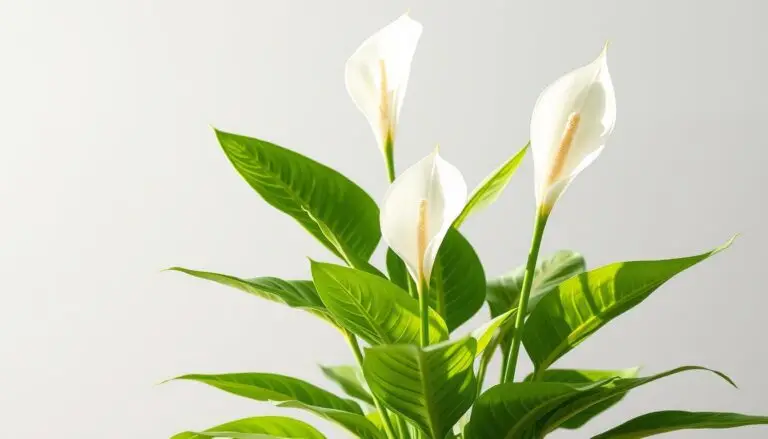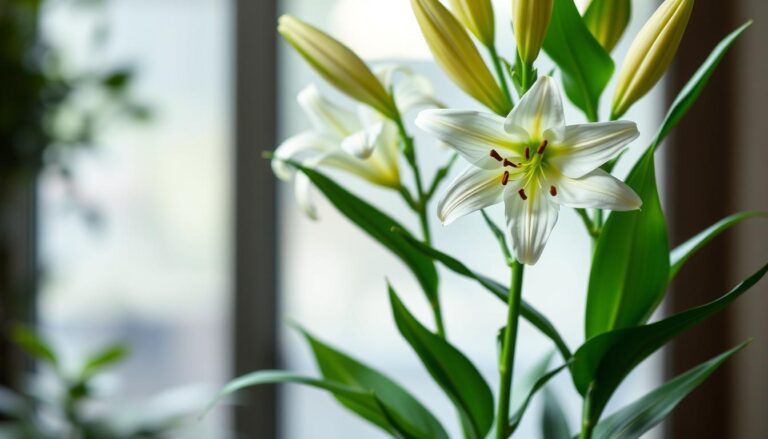How to Master Pitcher Plant Care: Essential Growing Tips
Have you ever paused to admire the otherworldly beauty of a Nepenthes? These carnivorous wonders, with their elegant pitchers and striking shapes, aren’t just plants—they’re living art. But keeping them thriving can feel like solving a delicate puzzle. I remember my first attempt: wilted leaves, dry traps, and frustration. Then I discovered a secret—success lies in mimicking their natural habitat.
Whether you’re nurturing your first specimen or refining your green thumb, this guide unlocks expert-backed strategies. You’ll learn how to balance moisture levels, create ideal light conditions, and avoid common pitfalls. Even seasoned growers find surprises in these tropical treasures’ preferences.
Tom Bennet, a botanist with 20 years’ experience, notes: “The difference between survival and flourishing? It’s in the details—like rainwater quality and seasonal adjustments.” We’ll explore real-world examples, from sunny windowsills to controlled greenhouse environments, giving you adaptable techniques for any setup.
Table of Contents
Getting Started with Pitcher Plant Care
Unlocking the secrets to thriving carnivorous specimens begins with three non-negotiable elements: airy soil, filtered light, and tropical humidity. These species evolved in nutrient-poor bogs, so standard potting mixes spell disaster. Your first mission? Ditch conventional gardening habits.
Understanding Your Plant’s Needs
Start with a blend of sphagnum moss and perlite—it mimics their natural substrate while preventing root suffocation. Bright, indirect light for 6-8 hours daily keeps leaves photosynthesizing without scorching. Hydration matters doubly: keep soil damp but never soggy, and maintain 60-80% ambient humidity.
Gathering Essential Tools and Supplies
Arm yourself with:
- A misting bottle for humidity boosts
- Distilled water containers (tap water kills)
- LED grow lights for darker spaces
- Moisture meters to prevent overwatering
Watch for new pitchers forming—their vibrant colors signal happy roots. Veteran grower Linda Torres advises: “Track weekly changes. If existing traps brown but new ones emerge, you’re on track.” Adjust your routine seasonally—less water in winter, more misting in summer heat.
Selecting the Right Environment for Your Pitcher Plants
Crafting the perfect habitat for these carnivorous wonders requires understanding their jungle roots. Their survival depends on precise combinations of light, moisture, and airflow—elements that transform ordinary spaces into thriving ecosystems.
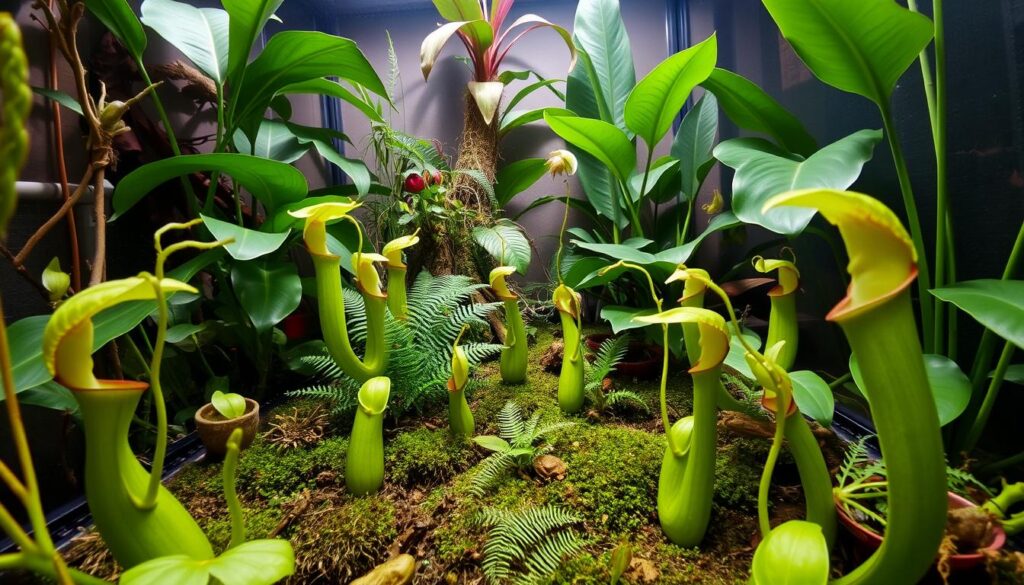
Light, Temperature, and Humidity Considerations
Bright but filtered illumination fuels growth without scorching leaves. Aim for 4-6 hours of direct sunlight daily, preferably morning rays. Afternoons demand shade to prevent dehydration. Maintain 70-85°F daytime temps with 10° nighttime drops to mimic natural cycles.
Humidity stays crucial—60% minimum. Use sphagnum moss in your soil mix to lock in moisture. Group specimens together or employ pebble trays for localized humidity boosts. Botanist Tom Bennet advises: “Consistent 70% humidity prevents pitcher collapse. Track levels with affordable hygrometers.”
| Environment | Light Source | Humidity Hack |
|---|---|---|
| Sunny Windowsill | Sheer curtain-filtered light | Daily misting |
| Indoor Terrarium | Full-spectrum LEDs | Automatic fogger |
| Greenhouse | Natural sunlight + shade cloth | Evaporative cooling |
Choosing Between Indoors and Greenhouses
South-facing windows work best for indoor setups. Rotate pots weekly for even growth. Greenhouses offer superior climate control but require ventilation systems to prevent stagnant air. For small spaces, try enclosed grow tents with adjustable vents.
Struggling with dry air? Line shelves with damp sphagnum moss—it releases moisture gradually. Bennet notes: “Seasonal shifts matter. Reduce watering in winter but maintain ambient humidity through substrate choices.”
Soil, Water, and Feeding: Essential Care Tips
Three elements determine whether your carnivorous specimens thrive or merely survive. Master these interconnected factors, and you’ll unlock vibrant growth while avoiding common pitfalls.
Creating the Ideal Soil Mix
Combine 2 parts long-fiber sphagnum moss with 1 part perlite. This airy blend mimics the species’ natural bog environment while preventing waterlogging. Experienced grower Linda Torres notes: “Fresh moss retains moisture better—replace it every 12-18 months to maintain drainage.”
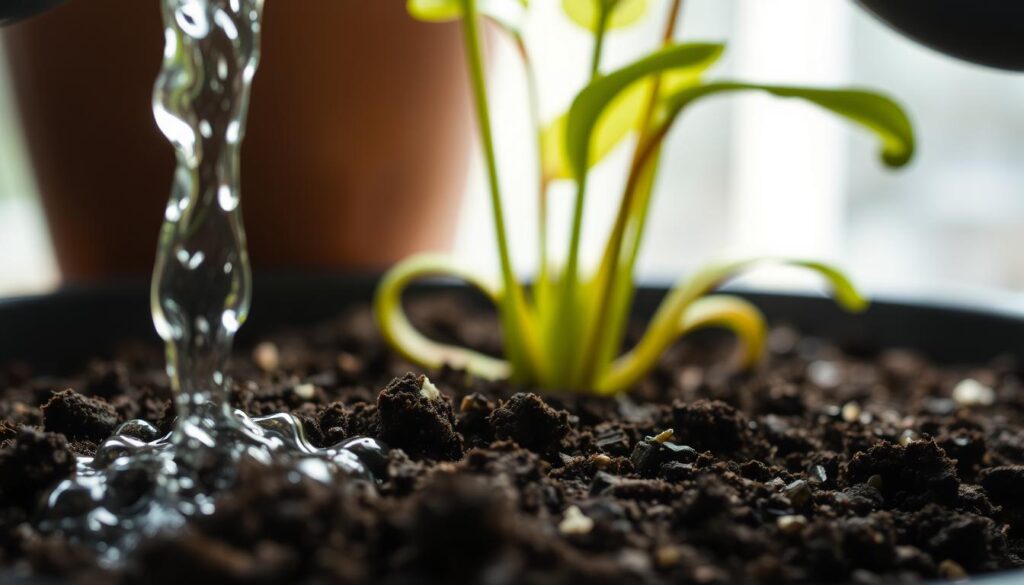
Watering Techniques That Protect Roots
Use rainwater or distilled water exclusively. Soak the soil until water drains freely, then wait until the top inch feels slightly dry. Overwatering symptoms include yellowing leaves and collapsed traps. A moisture meter helps prevent guesswork.
Balancing Nutritional Needs
Healthy nepenthes catch enough insects naturally. If growing indoors, apply diluted seaweed fertilizer (1/4 strength) to one pitcher monthly. Botanist Tom Bennet warns: “Overfed specimens produce fewer traps—their roots evolved for lean conditions.”
| Factor | Ideal Range | Risk Zone |
|---|---|---|
| Water pH | 5.0-6.5 | Above 7.0 |
| Fertilizer Frequency | Monthly (indoor) | Weekly |
| Soil Temperature | 70-80°F | Below 60°F |
Special Considerations for Different Pitcher Plant Species
Not all carnivorous species play by the same rules—their needs shift dramatically across the globe’s diverse habitats. Hybrid varieties often tolerate home environments better than pure species, which demand precise conditions mirroring their native ecosystems.
Hybrid vs. Pure Species: What You Need to Know
Hybrids like Nepenthes × ventrata adapt well to typical home humidity (50-60%), while pure species like Sarracenia purpurea require 70%+ moisture. Use a humidifier for finicky varieties—position it 3 feet away to prevent leaf burn.
| Type | Watering Frequency | Food Needs | Sphagnum Ratio |
|---|---|---|---|
| Hybrids | Every 3 days | Light supplementation | 50% mix |
| Pure Species | Daily misting | Natural prey only | 80%+ |
Adapting Care for Specific Varieties
Nepenthes thrive in airy sphagnum blends with weekly rainwater showers. Sarracenia prefer tray watering and direct sunlight. Botanist Tom Bennet shares: “I’ve grown 47 varieties—the key is observing pitcher color. Deep reds mean ideal light; pale greens signal hunger.”
For nutrient-hungry types, offer dried insects monthly. Avoid fertilizers—their roots evolved in low-food environments. In dry homes, place pots over damp pebble trays to boost humidity naturally.
Troubleshooting Common Pitcher Plant Issues
Even experienced growers face puzzling symptoms. Catching issues early transforms struggling specimens into vigorous growers. Let’s decode the silent language of stressed carnivorous flora.
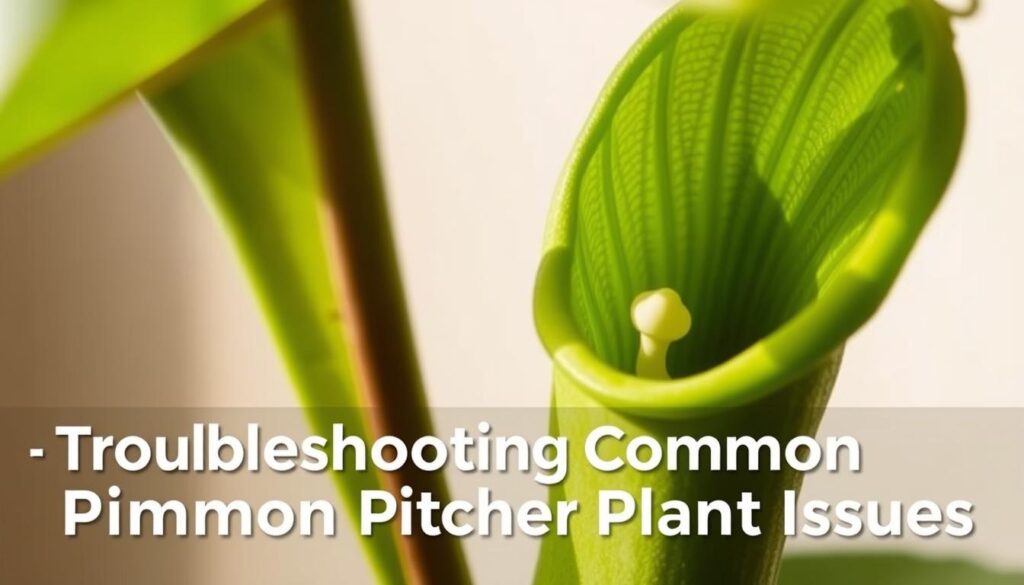
Water Woes: Reading the Signs
Yellow leaves often scream overwatering. Check your drainage—if water pools for hours, boost perlite in the moss mix. Drooping pitchers? Underwatering’s likely. Press a finger into the soil: dryness beyond 1 inch demands hydration.
Botanist Tom Bennet advises: “Sunlight and water dance together. More sun means faster drying—adjust your schedule weekly.” Use transparent saucers to monitor runoff. White crusts signal mineral buildup—switch to rainwater immediately.
| Symptom | Likely Cause | Immediate Action |
|---|---|---|
| Blackened leaf tips | Low humidity | Mist with distilled water |
| Stunted growth | Poor nutrients | Add dried insects to 1 pitcher |
| Mold on soil | Stagnant air | Increase airflow |
Balance sunlight exposure carefully. Pale leaves crave more light; scorched spots demand shade cloth. For persistent issues, repot using fresh moss and sterilized tools. Mix 30% perlite into your substrate for optimal drainage.
Watch new growth—it reveals recovery progress. Healthy roots produce vibrant traps within 3 weeks. Adjust one variable at a time to pinpoint solutions.
Optimizing Your Home or Greenhouse Setup
Transforming your space into a thriving ecosystem starts with smart design choices. Whether working with a sunny window ledge or a custom greenhouse, strategic layouts bridge the gap between human habitats and jungle-like needs.
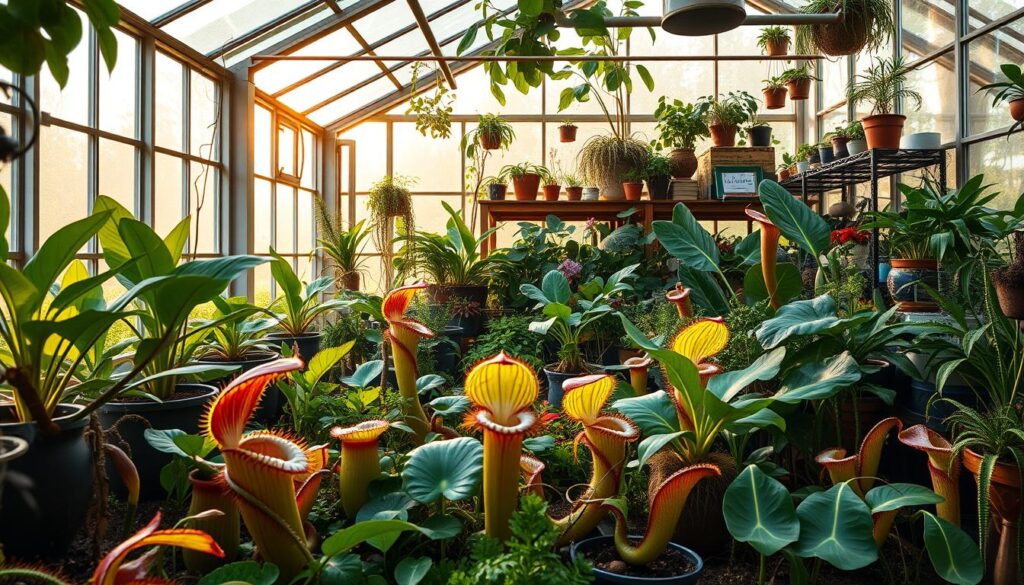
Creative Spaces for Healthy Growth
South-facing windows become prime real estate when positioned less than 12 inches away. Use adjustable shelves to rotate specimens weekly, ensuring even light distribution. During dormancy periods, shift pots 6 inches back to reduce intensity.
Enclosed terrariums with LED strips offer controlled environments. Line their bases with rainwater-soaked sphagnum moss for steady humidity release. Grow tents with ventilation flaps outperform open shelves in dry climates, maintaining 70% moisture with minimal effort.
| Setup Type | Light Solution | Humidity Source |
|---|---|---|
| Windowsill | Morning sunlight | Pebble tray + daily misting |
| Terrarium | Full-spectrum LEDs | Automated fogger |
| Grow Tent | Dimmable panels | Humidifier with timer |
Climate Control Made Simple
Group specimens near rainwater reservoirs—evaporation creates localized humidity pockets. For sun-drenched rooms, apply UV-filtering window film to prevent leaf burn. Expert grower Linda Torres suggests: “Track daily fluctuations. If midday temps spike above 90°F, add oscillating fans to mimic jungle breezes.”
Winter dormancy demands adjustments: reduce watering frequency but maintain ambient moisture through closed terrariums or humidity domes. Use digital hygrometers to monitor conditions—ideal ranges appear in this guide’s earlier sections.
Conclusion
Mastering these carnivorous beauties demands balancing science with observation. Your success hinges on three pillars: environmental requirements, precise soil mix, and consistent moisture management. Blend sphagnum moss with perlite for root-friendly drainage, and monitor hydration like a rainforest steward.
Create a quick-care checklist:
• 6-8 bright hours daily (filtered light preferred)
• Distilled or rainwater only
• 60%+ humidity through pebble trays or misting
• Monthly insect supplements if traps stay empty
Dedicate hours weekly to study your specimen’s signals—discolored leaves reveal water issues, while stunted growth hints at poor mix quality. Adjust requirements seasonally: reduce watering in winter, boost airflow during summer heat spikes.
Remember: thriving specimens emerge from tailored routines. Track moisture levels with meters, test light intensity through leaf coloration, and refine your approach using collected data. Your efforts now create a sustainable ecosystem where these exotic wonders flourish year-round.

